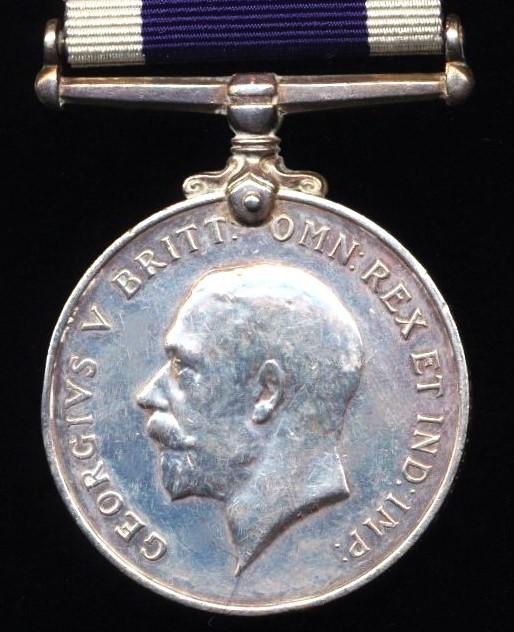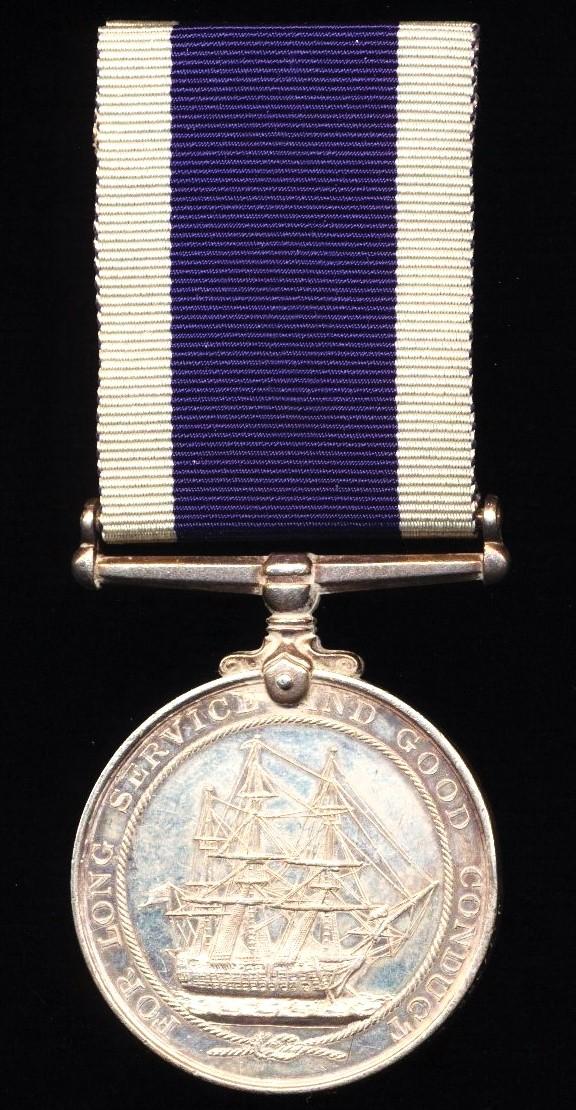Naval Long Service and Good Conduct Medal. GV coinage head (J.77952 E. C. Sandercock. A. B. H.M.S. Furious.)
Medal verification: In addition to his Naval LSGC, the recipient was also entitled to campaign medals for the Great War. The respective medal roll references are:
- British War Medal. Silver issue: Ref Adm 171/144 sent to recipient at H.M.S. Vivid
- Interallied Victory Medal: Ref Adm 171/144 sent to recipient at H.M.S. Vivid
- Naval Long Service and Good Conduct Medal: Shown in recipients extant service sheet as 'Traced ', 25 April 1933 (see Admiralty medal roll ref ADM 171/151)
Important: Able Seaman Edward Charles Sandercock served as a crew member of the Aircraft Carrier H.M.S. Furious from 29 August 1933 until 5 June 1936
Edward Charles Sandercock, son of David Charles Sandercock (a sailor in the Royal Navy) and Emma Louisa Sandercock (nee May) was a native of Exeter, Devon, England, where he was born on, 5 April 1902. Edward had been working as a 'Factory Boy' prior to joining the Royal Navy, on, 14 September 1917. On joining the Royal Navy he was only 15 years of age, and was posted to the boy's training ship, H.M.S. Impregnable, where he was rated as Boy II, and promoted to Boy I on, 2 March 1918 . He was posted to the Armoured Cruiser H.M.S. Duke of Edinburgh on, 25 May 1918, and served on the ship until being posted to H.M.S. Vivid I on 4 August 1918. In the post-war years, he recorded postings to several capital ships, including to: H.M.S. Tiger (Battlecruiser) H.M.S. Queen Elizabeth (Battleship) and H.M.S. Valiant (Battleship). The recipients longest posting, was arguably his most prestigious when he joined the crew of the Aircraft Carrier H.M.S. Furious on 29 August 1933. Edward Charles Sandercock resident of, 4 Dinham Road, St. David's, Exeter, is recorded to have died at Frenchay Hospital Bristol England, on 23 June 1951. His estate was left to his widow Irene Sandercock (nee Laskey) of Exeter
HMS Furious Aircraft Carrier: Was a modified Courageous-class battlecruiser built for the Royal Navy (RN) during the First World War. Designed to support the Baltic Project championed by the First Sea Lord, Lord Fisher, the ship was very lightly armoured and designed with a main battery of only two 18-inch (457 mm) guns. Between 1921-25, Furious was modified for conversion to become an aircraft carrier. Her forward turret was removed and a flight deck was added in its place, such that aircraft had to manoeuvre around the superstructure to land. Later in the war, the ship had her rear turret removed and a second flight deck installed aft of the superstructure, but this was less than satisfactory due to air turbulence. Furious was briefly laid up after the war before she was reconstructed with a full-length flight deck in the early 1920s.
After her conversion, Furious was used extensively for trials of naval aircraft and later as a training carrier once the new armoured carriers like Ark Royal entered service in the late 1930s. During the early months of the Second World War, the carrier spent her time hunting for German raiders in the North Atlantic and escorting convoys. This changed dramatically during the Norwegian Campaign in early 1940 when her aircraft provided air support to British troops ashore in addition to attacking German shipping. The first of what would be numerous aircraft ferry missions was made by the carrier during the campaign. After the withdrawal of British troops in May, Furious made several anti-shipping strikes in Norway with little result before beginning a steady routine of ferrying aircraft for the Royal Air Force.
At first, Furious made several trips to West Africa, but she began to ferry aircraft to Gibraltar in 1941. An unsuccessful attack on German-occupied ports on the Arctic Ocean interrupted the ferry missions in mid-1941. Furious was given a lengthy refit in the United States and spent a few months training after her return in April 1942. She made several more ferry trips in mid-1942 before her aircraft attacked airfields in Vichy French Algeria as part of the opening stages of Operation Torch in November 1942. The ship remained in the Mediterranean until February 1943 when she was transferred to the Home Fleet.
Furious spent most of 1943 training, but made a number of attacks on the German battleship Tirpitz and other targets in Norway during the first half of 1944. By September 1944, the ship was showing her age and she was placed in reserve. Furious was decommissioned in April 1945, and later sols for 'Scrap' in 1948.
The recipients 'Service Sheets' are extant and are held & accessible at The National Archives
Condition: VF
Code: 23469
100.00 GBP







